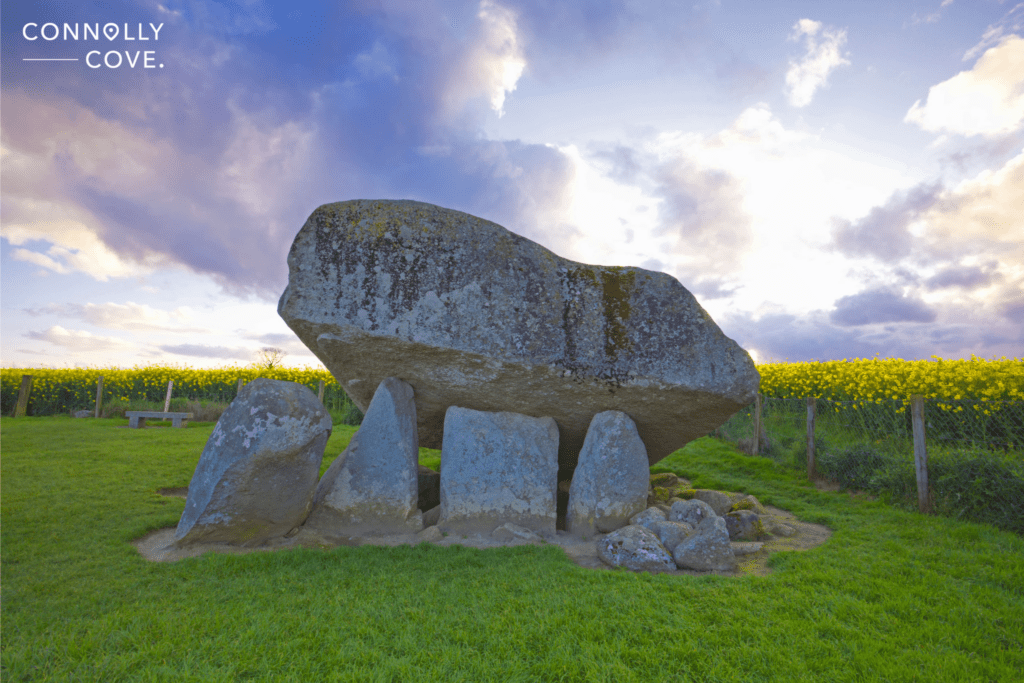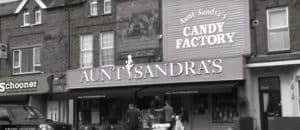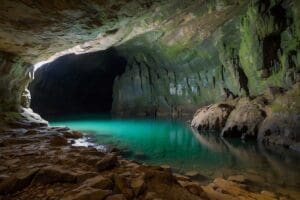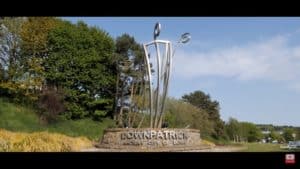The Enticing Nature of Carlow County

Updated On: April 05, 2024 by ConnollyCove
Often, people think of Carlow County as the second smallest county in Ireland or the third smallest in population, but there is much more to the county than this! Carlow is a place of rich pastures and rural landscapes, situated in the southeast of the country beside counties Wicklow, Wexford, Kilkenny, Laois, and Kildare.
Part of the designated journey through Ireland’s Ancient East, this county is included in the landlocked Historic Heartlands region, where castles, battles, legends, traditions and ancient races are ever present in the landscape.
Table of Contents
The Heart of Carlow County
Carlow is essentially a county of rolling farmland, with the scenic Blackstairs Mountains bordering the county to the south and the historic Barrow River Valley running through the centre. The county town is Carlow Town, an up-and-coming market town. Located centrally on the banks of the River Barrow, a vibrant farmer’s market takes place every week.
The most prominent building in the town is The Courthouse, modelled after the Parthenon in Athens. This majestic building was initially meant for Cork County until the plans were finalised. The county was once known as the King’s County, and neighbouring Laois was known as the Queen’s County.
History of Carlow County
Settlement in Carlow predates written Irish history. The area has been inhabited for thousands of years. Carlow town on the River Barrow was historically a significant stronghold. The ancient inhabitants of the Carlow area left behind numerous monuments, including the Brownshill Dolmen, which had a capstone that was said to be the heaviest of its type in Europe.
Beginning in 1169, the Normans invaded and conquered much of Ireland, first taking the province of Leinster. The strategic position of Carlow on the River Barrow was evident, and Carlow town became a significant fortress created by William Marshall, 1st Earl Of Pembroke. It existed until 1814 when its walls were finally demolished. All that remains of the original structure are two circular towers bookending a portion of a stone wall.
Other significant medieval castles in the Carlow area included fortresses at Ballymoon and Leighlinbridge. Carlow County had seven baronies, including Carlow, Forth, Idrone East, Idrone West, Rathvilly, St Mullin’s Lower and St Mullin’s Upper.
The history of Carlow County reflected the turbulent history of the rest of Ireland, which saw centuries of conflict between the native Gaelic population and the Anglo-Norman and later Anglo-Irish Protestant population. During the 19th century, Ireland’s Great Hunger wiped out half of the city’s population. A centre of agriculture, the first outbreak of the dreaded potato blight was reported in September 1845.
Carlow Town
The largest town in Carlow County, Carlow, is known as the Celtic Centre of Ireland. Near the town is the tiny Sleaty Church, where the oldest Christian manuscript, ‘The Life of Saint Patrick,’ was said to originate.
Despite its size, the town hosts an impressive array of festivals yearly. These culminate in the Feile an Fhomhair Carlow, a five-day bilingual festival in October with an environmental theme. The town is also home to the famous Carlow Golf Club.
Riverside
The focus of Ireland’s second-smallest county is the River Barrow. Ireland’s second-longest river. Which flows south from Carlow town through several picturesque villages to the monastic hamlet of St Mullins. It’s a towpath followed by the lovely Barrow Way walking trail.
The Barrow is one of the three sister rivers, along with the Nore and the Suir. It has the most developed navigation of the three, and the long stretches of pleasure waterways through Co. Carlow attract many people seeking to relax in its peaceful surroundings.
The valley’s beauty, which the River Barrow has carved through the countryside, and the rich variety of wildlife surrounding it attract environmental specialists, botanists, ecologists, and ornithologists to the area.
Carlow’s Nature
Ireland may have 40 shades of green, but Carlow can cater for 40 shades of green fingers.
The Carlow Garden Trail
Open to visitors and tourists all year round, The Carlow Garden Trail currently features 16 different gardening attractions with an additional two gardens in the surrounding counties of Kildare and Wexford.
Moreover, The Carlow Garden Trail includes excellent old gardens that have been lovingly restored and maintained throughout the years and smaller gardens maturing beautifully with time. Award-winning garden centres and forest parks complement the joy of a visit there.
Altamont House and Gardens
The establishment of Altamont, which extends over some 40 acres. Has been in the care of a long line of gardeners. Astonishingly, there are trees in the garden dating back to 1750 and even older ones in the glen by the river, including 500-year-old oaks.
Altamont House was named circa 1760. It was previously known as “Rose Hill” and later “Soho.” The central portion of the house dates from the Seventeenth Century. Interestingly, the house was extensively altered in the Eighteenth Century. A porch with an alluring fanlight and a low dining room were built.
The garden’s many varieties of mature trees give it its character, but there are also excellent perennial borders bursting with rare azaleas, rhododendrons, magnolias, and more. The lake is the most peaceful and serene part of the garden, its perimeter lined with trees and its surface covered in waterlilies.
Of course, you don’t have to be a gardener to get the most out of Carlow’s gardens, as it’s replete with other seductive landscapes. In the dips and meanders of the River Barrow and, rising above it, the rugged peaks of the Blackstairs Mountains.
But Carlow has its wild side, too. Think of Mount Leinster, the highest peak in the Blackstairs Mountains, where you’ll see adrenaline junkies paragliding on the thermals, their colourful chutes bursting like bubblegum as they hit the valley floor.
Carlow Food
Food production in Carlow has progressed rapidly in the last few years. A diversity of products is now made or grown here. The most tempting are craft beers and whiskey, farmhouse cheeses, artisan chocolate, superb meats from livestock reared on rich grass pastures, free-range eggs, preserved city-grown fruit, and much more.
Want to discover more Irish food? Click here.
Most Popular Places in Carlow
Brownshill Dolmen

One unmistakable monument dating back to prehistoric times is the excellent Brownshill Dolmen, east of Carlow town. Weighing about 103 tonnes, it has excited the interest of historians and antiquarians for centuries. An enormous slab sits on two portal stones flanking a door stone and slopes downwards to the west, resting on a low boulder.
Built between 4000 and 3000 B.C., the entrance is flanked by two large upright stones (orthostats) supporting the granite capstone of the chamber. The capstone is thought to have been covered by an earthen mound, and a gatestone blocked the entrance.
Both portal stones and the gate-stone are still in situ; the capstone lies on top of the portals and gate-stone and slopes to the ground away from the entrance. It has never been excavated.
VISUAL Centre for Contemporary Art at the George Bernard Shaw Theatre
VISUAL Carlow is an iconic cultural space in the heart of Carlow Town. It presents contemporary art, theatre, music, dance, cinema, talks, workshops, private conference events, and more.
The 3,000-square-meter building comprises a 353-seat theatre and stage area, four principal gallery spaces, stores and workshop areas, a restaurant, and theatre-bar facilities. The theatre has the latest audiovisual equipment, a superb lighting system, and a flexible stage that can accommodate an orchestra pit.
Plans to build an arts centre in Carlow have been promoted for over 30 years since the annual Éigse Arts Festival was founded in 1979. The VISUAL Centre for Contemporary Art and The George Bernard Shaw Theatre are excellent examples of the high level of initiative locally in Carlow.
Delta Sensory Gardens
Delta Sensory Gardens, eloquently described as an oasis of peace and tranquillity, consists of a series of interconnecting multi-sensory gardens covering one hectare on the outskirts of Carlow Town. They are now well renowned and mature, having been open to the public for the past eight years. Their visitor numbers are growing steadily, with many repeat visitors and word-of-mouth advertising.
There is always something different from season to season in the 16 interconnecting gardens, offering visitors of all ages a unique opportunity to rest and indulge their senses of touch, taste, smell, hearing and visual delight.
Carlow County Museum
Located in the heart of Carlow Town, Carlow County Museum offers an enriching experience of Carlow’s heritage and culture. It is a fantastic representation of Carlow‘s history.
Furthermore, the exhibits are so varied that there is most definitely something for everyone. The museum’s four galleries display exhibits, from Carlow Castle and the Gaol Gallows on the ground floor to the military and ecclesiastical exhibits on the first floor. There’s enough to pique anyone’s interest in town.
Duckett’s Grove
Duckett’s Grove is a castellated 19th-century Great House whose towers and turrets, formerly centred on a 12,000-acre estate, have dominated the vast flat landscape for over 200 years and miles around.
Moreover, The mansion was transformed into a spectacular castellated Gothic fantasy by Thomas A. Cobden for J. D. Duckett in 1830. It incorporates numerous round, square and octagonal towers and turrets. One very tall octagonal turret rises from the structure. Duckett’s Grove is elaborately ornamented with oriels and niches containing statues. Several statues on pedestals surrounded the building and lined the approaches.
Furthermore, Duckett’s Grove is open to the public, with visitors touring the extensive gardens and woodlands. For those who look at the remains of the Gothic skeleton, it is a statuesque reminder of the opulent and lavish lifestyle that used to be lived within. For those who are braver, the ruins provide a hive of paranormal occurrences to be witnessed from the brightest and busiest of tourist days to the dead of night.
Carlow County has retained plenty of “old world” charm. So, making time for a stopover there should be gratifying. There are many things to see and explore. Overall, it is quite a pleasant Irish county town for a walk and some snapshots. And there are some decent (ancient and modern) entertainment venues there, too.
Borris House
One of Ireland’s most beautiful houses, Borris House, is in Carlow County. Morgan Kavanagh built the house in 1731. For many years, it was the home of the MacMorrough Kavanagh family, who were Celtic Kings of Leister.
The house was severely damaged in the late 1700s and brought back to life in the early 1800s by Richard and William Morrison, a father-son duo.
Nowadays, visitors can visit the beautiful houses and picturesque gardens that complete the estate. They can also see what the countryside of Carlow County has to offer, including views across Mount Leister, Blackstair Mountains, and Barrow Valley.
Worthy reads about places in Ireland:
Kilkenny: The Splendid Reflection of the History of Ireland| Dublin: The World’s Natural Wonders in One City| An Insight into the Fascinating Nature of County Derry| The Beauty of County Kildare| Famous Landmarks in Ireland| County Leitrim: The Most Brimming Gem of Ireland| Your Guide Around the Lake-Land, County Cavan|






